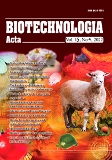ISSN 2410-7751 (Print)
ISSN 2410-776X (Online)

Biotechnologia Acta V. 15, No. 4, 2022
P. 44-46. Bibliography 7, Engl.
UDC: 616.36-008.5-02:616-006: 616.361-022-089.48-089.197.5
https://doi.org/10.15407/biotech15.04.044
Y.M. Susak1, R.Y. Palitsa2, L.Yu. Markulan1, M.V. Maksуmenko1
1Bogomolets National Medical University, Kyiv, Ukraine
2Main military clinical hospital, Kyiv, Ukraine
The purpose of this study was comparative assessment of the frequency of bacterial colonization of the bile in patients with hilar malignant biliary obstruction after the palliative biliary decompression using different methodological approaches.
Methods. 50 patients with proximal mechanical jaundice of tumor origin aged of ~ 62 years (25 males and 25 females), who were on steady-state treatment in Main military clinical hospital (Kyiv, Ukraine) were recruited in this prospective study. All patients underwent cholangiostomy using percutaneous transhepatic (PTBD) and external-internal suprapapillary (EISBD) approaches. Bile specimens were taken right after the biliary drainage. Identification of bacterial isolates was performed using standard cultural and biochemical methods.
Results. The incidence of cholangitis was almost twice lower in EISBD group (n=26) than in PTBD group (n=24): 25.6% vs 49.1%. The rates of bacteriobilia did not differ significantly in patients from different groups: 23.1% in EISBD group and 25.0% in PTBD group. However, the frequency of biliary bacterial colonization coupled with cholangitis was also 2 times lower in EISBD group in comparison with patients underwent PTBD: 7.7% vs 16.7%. Escherichia coli predominated in bile specimens from patients with bacteriobilia associated with cholangitis in both groups.
Conclusions. The use of EISBD for palliative biliary decompression in patients with proximal mechanical jaundice of tumor origin is associated with lower risk of bacterial colonization of the bile as compared to PTBD approach, and as a result with less risk of the development of infectious complications
Key words: hilar malignant biliary obstruction, biliary decompression methodology, bacteriobilia
© Palladin Institute of Biochemistry of the National Academy of Sciences of Ukraine, 2022
References
1. Pan H., Liang Z., Yin T. S., Xie Y., Li D. W. Hepato-biliary-enteric stent drainage as palliative treatment for proximal malignant obstructive jaundice. Med Oncol. 2014, 31(3), 853. https://doi.org/10.1007/s12032-014-0853-3
2. Narkhede R., Desai G., Pande P. Bacteriobilia in Hepato-Pancreato-Biliary Surgery: an Enemy or a Friend in Disguise? Indian J. Surg. 2019, v. 81, 479–484. https://doi.org/10.1007/s12262-019-01933-0
3. Loeuillard E., Conboy C. B., Gores G. J., Rizvi S. Immunobiology of cholangiocarcinoma. JHEP Rep. 2019, 1(4), 297?311. https://doi.org/10.1016/j.jhepr.2019.06.003
4. Lan T., Qian S., Tang C., Gao J. Role of Immune Cells in Biliary Repair. Front Immunol. 2022, v. 13, 866040. https://doi.org/10.3389/fimmu.2022.866040
5. Vagholkar K. Obstructive jaundice: understanding the pathophysiology. International Journal of Surgery and Medicine. 2020, 6(4), 26?31. https://doi.org/10.5455/ijsm.2020-07-061-jaundice
6. Sano T., Ajiki T., Takeyama Y., Kuroda Y. Internal biliary drainage improves decreased number of gut mucosal T lymphocyte and MAdCAM-1 expression in jaundiced rats. Surgery. 2004, 136(3), 693?699. https://doi.org/10.1016/j.surg.2004.02.001
7. Yan M, Hou L, Cai Y, Wang H, Ma Y, Geng Q, Jiang W, Tang W. Effects of Intestinal FXR-Related Molecules on Intestinal Mucosal Barriers in Biliary Tract Obstruction. Front Pharmacol. 2022, 13, 906452. https://doi.org/10.3389/fphar.2022.906452

